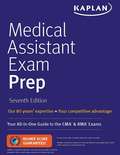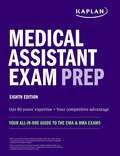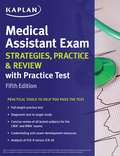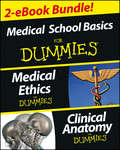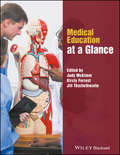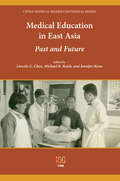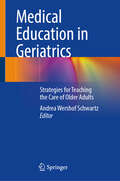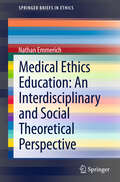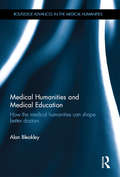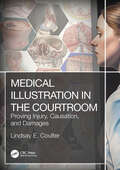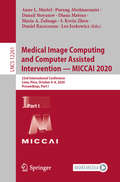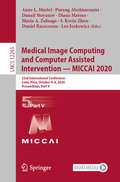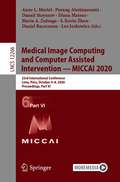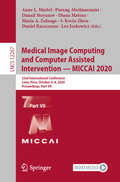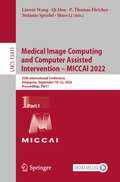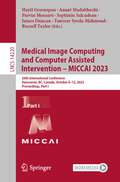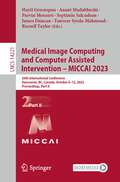- Table View
- List View
Medical Assistant Exam Prep: Your All-in-One Guide to the CMA & RMA Exams
by Kaplan NursingKaplan's Medical Assistant Exam Prep provides the in-depth content, comprehensive review, and targeted practice you need to pass the Certified Medical Assistant and Registered Medical Assistant exams. Whether you're a first-time test taker or you're studying for recertification, Kaplan's up-to-date content and proven test-taking strategies will help you face the exam with confidence.Comprehensive ReviewReview of all tested subjects for the CMA and RMA examsDiagnostic test to help you target areas for score improvement and make the most of your study timeFull-length practice test with 300 questionsEnd-of-chapter quizzes with detailed answer explanationsCase study–based practice questions to develop your critical thinking skillsNew discussions including: the medical assistant&’s role in emergency preparedness and the Patient-Centered Medical Home (PCMH) model of careUpdated discussions including: electronic health records (EHRs), personal health records (PHRs), and patient rights; guidelines for reporting healthcare data breaches; billing procedures; and day-to-day electronic communications in the medical officeExpert GuidanceExpert advice on building and maintaining professional credentialsUpdated career resources and a guide to the certification processWe invented test prep—Kaplan (www.kaptest.com) has been helping students for almost 80 years. Our proven strategies have helped legions of students achieve their dreams.
Medical Assistant Exam Prep: Your All-in-One Guide to the CMA & RMA Exams (Kaplan Test Prep)
by Kaplan NursingKaplan's Medical Assistant Exam Prep provides the in-depth content, comprehensive review, and targeted practice you need to pass the Certified Medical Assistant and Registered Medical Assistant exams. Whether you're a first-time test taker or you're studying for recertification, Kaplan's up-to-date content and proven test-taking strategies will help you face the exam with confidence. Kaplan is so certain that Medical Assistant Exam Prep offers all the knowledge you need to pass the exam that we guarantee it: After studying with the book, you'll score higher on your medical assistant exam—or you'll get your money back.Comprehensive ReviewReview of all tested subjects for the Certified Medical Assistant (CMA) and Registered Medical Assistant (RMA) examsDiagnostic test to help you target areas for score improvement and make the most of your study timeFull-length practice test with 300 questionsEnd-of-chapter quizzes with detailed answer explanationsCase study–based practice questions to develop your critical thinking skills, now with 2 NEW case studies!Updated professional resources with advice for building an electronic portfolioNew discussions including: Covid-19, pediatric vaccinations, telehealthNew back-of-book Reference Guide with quick facts at your fingertips: normal vital signs, EKG leads & interpretation, order of draw, and moreExpert GuidanceExpert advice on building and maintaining professional credentialsUpdated career resources and a guide to the certification processWe invented test prep—Kaplan (www.kaptest.com) has been helping students for almost 80 years. Our proven strategies have helped legions of students achieve their dreams.
Medical Assistant Exam Strategies, Practice & Review with Practice Test
by KaplanEverything you need to pass the CMA and RMA exams.Medical Assistant Exam Strategies, Practice & Review with Practice Test provides targeted review and practice for the Certified Medical Assistant and Registered Medical Assistant exams, as well as a guide to the certification process.FEATURES:* Diagnostic test to target areas for score improvement* Review of all tested subjects for the CMA and RMA exams* End-of-chapter quizzes* Full-length practice test with 300 questions* Detailed answer explanations* Up-to-date information on exam content, structure, and registration* Analysis comparing/contrasting ICD-9 and ICD-10* Current guidelines for Electronic Health Records* Career-development resources for medical assistants* Guidance on building and maintaining professional credentials
Medical Attendance Rules
by Muthuswamy Brinda SanjeevCS (Medical Attendance) Rules with up-to-date Instructions and Orders Treatment of family members Treatment for special diseases Provision of artificial appliances Recognized private Hospitals various States Recognition of Indian and Homeopathic Systems of Medicine List of Ayush Hospitals /Centres for Ayurveda/ Unani and Yoga Naturopathy treatments procedures List of inadmissible medicines under Allopathy Systems Revised list of admissible medicines under Indian and Homoeopathic Systems and Forms
Medical Billing & Coding For Dummies
by Karen SmileyThe essential guide for medical billing professionals, updated for ICD-11 standards Medical Billing & Coding For Dummies will set you up for success in getting started as a medical biller and coder. To ensure data accuracy and efficient data processing, medical offices need professionally trained coders to handle records. This book provides prospective allied health professionals with everything they need to know to get started in medical billing and coding as a career. In addition to an introduction to the basics of medical coding, you'll get information on how to find a training course, meet certification requirements, and deal with government agencies and insurance companies. Learn about the standard practices in the medical billing industry and get up to speed on the ethical and legal issues you're likely to face on the job. This accessible guide is a great entry point—and a great refresher—for anyone interested in the medical billing and coding profession. Get a primer on your career options in the field of medical billing Learn coding practices for telehealth, viral outbreaks, and other emerging issues Update your knowledge of the changes between ICD-10 and ICD-11 coding systems Find training programs and explore your options for certification This Dummies guide is an accessible entry point for prospective professionals looking get a jump on their new career, and current professionals intent on staying up-to-date in this flexible and growing field.
Medical Career Basics Course For Dummies, 2 eBook Bundle: Medical Ethics For Dummies & Clinical Anatomy For Dummies
by Linda Johnson Larsen Shereen Jegtvig Jane Runzheimer David TerferaTwo complete ebooks for one low price! Created and compiled by the publisher, this medical school basics bundle brings together two of the bestselling For Dummies medical school titles in one, e-only bundle. With this special bundle, you’ll get the complete text of the following titles: Medical Ethics For Dummies Succeeding in the healthcare field means more than just making a diagnosis and writing a prescription. Healthcare professionals are responsible for convincing patients and their family members of the best course of action and treatments to follow, while knowing how to make the right moral and ethical choices. Unlike daunting and expensive texts, Medical Ethics For Dummies offers an accessible and affordable course supplement for anyone studying medical or biomedical ethics and includes moral issues surrounding stem cell research, genetic engineering, euthanasia, and much more. Clinical Anatomy For Dummies Clinical anatomy is the study of human anatomy as it relates to clinical practice. Unlike a basic anatomy and physiology course designed to teach general anatomical knowledge, clinical anatomy focuses on specific structures and issues that people may encounter in a clinical setting. Loaded with clear definitions, concise explanations, and plenty of full-color illustrations, Clinical Anatomy For Dummies presents a friendly, unintimidating overview of the material covered in a typical college-level Clinical Anatomy course. About the Authors of Medical Ethics For Dummies Jane Runzheimer, MD, is a family physician who has served on the Ethics Committee of Methodist Hospital in St. Louis Park, Minnesota. Linda Johnson Larsen has written 24 books, many of which have an emphasis on health, and has been a patient advocate for her husband and several family members. About the Authors of Clinical Anatomy For Dummies David Terfera, PhD, teaches biomedical sciences at the University of Bridgeport College of Naturopathic Medicine. Shereen Jegtvig, DC, MS, is a health and nutrition writer.
Medical Decision Making
by Alan Schwartz George BergusDecision making is a key activity, perhaps the most important activity, in the practice of healthcare. Although physicians acquire a great deal of knowledge and specialised skills during their training and through their practice, it is in the exercise of clinical judgement and its application to individual patients that the outstanding physician is distinguished. This has become even more relevant as patients become increasingly welcomed as partners in a shared decision making process. This book translates the research and theory from the science of decision making into clinically useful tools and principles that can be applied by clinicians in the field. It considers issues of patient goals, uncertainty, judgement, choice, development of new information, and family and social concerns in healthcare. It helps to demystify decision theory by emphasizing concepts and clinical cases over mathematics and computation.
Medical Education at a Glance
by Judy Mckimm Kirsty Forrest Jill ThistlethwaiteCovering the core concepts, activities and approaches involved in medical education, Medical Education at a Glance provides a concise, accessible introduction to this rapidly expanding area of study and practice. This brand new title from the best-selling at a Glance series covers the range of essential medical education topics which students, trainees, new lecturers and clinical teachers need to know. Written by an experienced author team, Medical Education at a Glance is structured under the major themes of the discipline including teaching skills, learning theory,and assessment, making it an easy-to-digest guide to the practical skills and theory of medical education, teaching and learning. Medical Education at a Glance: Presents core information in a highly visual way, with key concepts and terminology explained. Is a useful companion to the Association for the Study of Medical Education’s (ASME) book Understanding Medical Education. Covers a wide range of topics and themes. Is a perfect guide for teaching and learning in both the classroom and clinical setting.
Medical Education for the Future
by Alan Bleakley John Bligh Julie BrowneThe purpose of medical education is to benefit patients by improving the work of doctors. Patient centeredness is a centuries old concept in medicine, but there is still a long way to go before medical education can truly be said to be patient centered. Ensuring the centrality of the patient is a particular challenge during medical education, when students are still forming an identity as trainee doctors, and conservative attitudes towards medicine and education are common amongst medical teachers, making it hard to bring about improvements. How can teachers, policy makers, researchers and doctors bring about lasting change that will restore the patient to the heart of medical education? The authors, experienced medical educators, explore the role of the patient in medical education in terms of identity, power and location. Using innovative political, philosophical, cultural and literary critical frameworks that have previously never been applied so consistently to the field, the authors provide a fundamental reconceptualisation of medical teaching and learning, with an emphasis upon learning at the bedside and in the clinic. They offer a wealth of practical and conceptual insights into the three-way relationship between patients, students and teachers, setting out a radical and exciting approach to a medical education for the future. "The authors provide us with a masterful reconceptualization of medical education that challenges traditional notions about teaching and learning. The book critiques current practices and offers new approaches to medical education based upon sociocultural research and theory. This thought provoking narrative advances the case for reform and is a must read for anyone involved in medical education." - David M. Irby, PhD, Vice Dean for Education, University of California, San Francisco School of Medicine; and co-author of Educating Physicians: A Call for Reform of Medical School and Residency "This book is a truly visionary contribution to the Flexner centenary. It is compulsory reading for the medical educationalist with a serious concern for the future - and for the welfare of patients and learners in the here and now." Professor Tim Dornan, University of Manchester Medical School and Maastricht University Graduate School of Health Professions Education.
Medical Education in East Asia: Past and Future (China Medical Board Centennial Series)
by Lincoln C. Chen, Michael R. Reich, and Jennifer RyanPivotal to Asia's future will be the robustness of its medical universities. Lessons learned in the past and the challenges facing these schools in the future are outlined in this collection, which offers valuable insights for other medical education systems as well. The populations in these rapidly growing countries rely on healthcare systems that can vigorously respond to the concerns of shifting demographics, disease, and epidemics. The collected works focus on the education of physicians and health professionals, policy debates, cooperative efforts, and medical education reform movements.
Medical Education in Geriatrics: Strategies for Teaching the Care of Older Adults
by Andrea Wershof SchwartzMedical Education in Geriatrics: Strategies for Teaching the Care of Older Adults provides an overview of evidence-based strategies for teaching geriatrics in medical education. This book is for clinician educators: both for those with geriatrics expertise seeking to increase their knowledge and skill in education, and for those medical educators seeking to expand their knowledge of how to teach geriatric principles to their learners and thereby prepare them to care for older adults. Written by experts and leaders in Geriatric Medical Education from across the US and Canada, Medical Education in Geriatrics highlights approaches for creating effective educational experiences in geriatrics for learners ranging from pre-clinical medical students, through residency, fellowship and continuing medical education, as well as interprofessional education, with an emphasis on evidence-based, engaging and memorable teaching strategies. The book also provides strategies for teaching geriatrics in a variety of settings, including the hospital, outpatient settings, nursing home, home care, and telemedicine. Additional chapters address considerations in teaching geriatrics, including Diversity, Equity and Inclusion, Providing Feedback, assessment in geriatric medical education, online resources, and other topics that will help educators deliver excellent medical education in geriatrics. Medical Education in Geriatrics: Strategies for Teaching the Care of Older Adults provides practical and evidence-based strategies for teaching principles of geriatrics in a variety of settings and will be a valuable and practical resource for geriatricians, palliative medicine specialists and trainees, family medicine and internal medicine clinicians and medical educators, medical educators in pre-clinical and clinical settings, residency and fellowship directors, and medical students and residents interested in geriatrics and the care of older adults.
Medical Education, Politics and Social Justice: The Contradiction Cure (Routledge Advances in the Medical Humanities)
by Alan BleakleyThis book critically analyses how politics and power affect the ways that medicine is taught and learned. Challenging society’s historic reluctance to connect the realm of politics to the realm of medicine, Medical Education, Politics and Social Justice: The Contradiction Cure emphasizes the need for medical students to engage with social justice issues, including global health crises resulting from the climate emergency, and the health implications of widening social inequality. Arguing for an increased focus on community-based learning, rather than acute care, this innovative text maps the territory of medicine’s contradictory engagement with politics as a springboard for creative curriculum design. It demonstrates why the socially disempowered - such as political and climate refugees, the homeless, or those without health insurance should be primary subjects of attention for medical students, while exploring how political engagement can be refined, sharp, cultivated and creative, engaging imagination and demanding innovation Exploring how the medical humanities can promote engagement with politics to improve medical education, this book is a ground-breaking and inspiring contribution. It is an essential read for all those with a focus on medical education and medical humanities, as well as medical and healthcare students with an interest in the social determinants of health.
Medical Ethics Education: An Interdisciplinary and Social Theoretical Perspective
by Nathan EmmerichThere is a diversity of 'ethical practices' within medicine as an institutionalised profession as well as a need for ethical specialists both in practice as well as in institutionalised roles. This Brief offers a social perspective on medical ethics education. It discusses a range of concepts relevant to educational theory and thus provides a basic illumination of the subject. Recent research in the sociology of medical education and the social theory of Pierre Bourdieu are covered. In the end, the themes of Bourdieuan Social Theory, socio-cultural apprenticeships and the 'characterological turn' in medical education are draw together the context of medical ethics education.
Medical Humanities and Medical Education: How the medical humanities can shape better doctors (Routledge Advances in the Medical Humanities)
by Alan BleakleyThe field of the medical humanities is developing rapidly, however, there has also been parallel concern from sceptics that the value of medical humanities educational interventions should be open to scrutiny and evidence. Just what is the impact of medical humanities provision upon the education of medical students? In an era of limited resources, is such provision worth the investment? This innovative text addresses these pressing questions, describes the contemporary territory comprising the medical humanities in medical education, and explains how this field may be developed as a key medical education component for the future. Bleakley, a driving force of the international movement to establish the medical humanities as a core and integrated provision in the medical curriculum, proposes a model that requires collaboration between patients, artists, humanities scholars, doctors and other health professionals, in developing medical students’ sensibility (clinical acumen based on close noticing) and sensitivity (ethical, professional and humane practice). In particular, this text focuses upon how medical humanities input into the curriculum can help to shape the identities of medical students as future doctors who are humane, caring, expressive and creative – whose work will be technically sound but considerably enhanced by their abilities to communicate well with patients and colleagues, to empathise, to be adaptive and innovative, and to act as ‘medical citizens’ in shaping a future medical culture as a model democracy where social justice is a key aspect of medicine. Making sense of the new wave of medical humanities in medical education scholarship that calls for a ‘critical medical humanities’, Medical Humanities and Medical Education incorporates a range of case studies and illustrative and practical examples to aid integrating medical humanities into the medical curriculum. It will be important reading for medical educators and others working with the medical education community, and all those interested in the medical humanities.
Medical Illustration in the Courtroom: Proving Injury, Causation, and Damages
by Lindsay E. CoulterMedical Illustration in the Courtroom: Proving Injury, Causation, and Damages educates the reader on how to communicate science visually—in personal injury, medical malpractice, criminal, and forensic cases—by creating art that utilizes medical records, radiographs, and computer software. Medical illustration bridges the gap between complex technical, medical, and scientific concepts to clearly illustrate, and explain visually, a medical condition, negligence, or the causation of an injury or death to the lay person. Medical artists are frequently challenged with illustrating injuries and medical conditions that can’t be seen by the naked eye. And while using medical photography and imaging for illustrative purposes can be helpful, to an untrained eye it can often be unclear or confusing. This is where the medical illustrator enters the equation. There are often patients who have recovered from an injury or infection that appear in good health. However, should an unforeseen injury or fatality happen, medical illustrators can reveal to people what’s actually going on inside the person, an invaluable asset to attorneys in the courtroom—especially for personal injury and medical malpractice cases. While many attorneys utilize medical artists, nonvisual people don’t always recognize the value of demonstrative aids until they see them first-hand.When attorneys and their clients enlist the aid of medical artists, it quickly becomes apparent that properly conceived and executed artwork is invaluable to illustrating the facts—and medical impacts—of any number of scenarios: homicides by shooting, stabbings, vehicular accidents, in addition to medical malpractice and personal injuries resulting from surgery or possible negligence.Presenting a myriad of services and computer technologies that can be utilized, Medical Illustration in the Courtroom provides demonstrative aids used in cases to illustrate personal injury and medical malpractice, employing "tricks of the trade" to create an accurate effective image. Such images are educational to attorneys, insurance adjusters, judges, and juries to help create a visual storyline, the goal being to help combine art and science to provide a clear illustration of events to help in adjudicate legal and forensic cases.
Medical Image Computing and Computer Assisted Intervention – MICCAI 2020: 23rd International Conference, Lima, Peru, October 4–8, 2020, Proceedings, Part I (Lecture Notes in Computer Science #12261)
by Leo Joskowicz Diana Mateus Maria A. Zuluaga Danail Stoyanov Daniel Racoceanu Purang Abolmaesumi Anne L. Martel S. Kevin ZhouThe seven-volume set LNCS 12261, 12262, 12263, 12264, 12265, 12266, and 12267 constitutes the refereed proceedings of the 23rd International Conference on Medical Image Computing and Computer-Assisted Intervention, MICCAI 2020, held in Lima, Peru, in October 2020. The conference was held virtually due to the COVID-19 pandemic.The 542 revised full papers presented were carefully reviewed and selected from 1809 submissions in a double-blind review process. The papers are organized in the following topical sections: Part I: machine learning methodologies Part II: image reconstruction; prediction and diagnosis; cross-domain methods and reconstruction; domain adaptation; machine learning applications; generative adversarial networks Part III: CAI applications; image registration; instrumentation and surgical phase detection; navigation and visualization; ultrasound imaging; video image analysis Part IV: segmentation; shape models and landmark detection Part V: biological, optical, microscopic imaging; cell segmentation and stain normalization; histopathology image analysis; opthalmology Part VI: angiography and vessel analysis; breast imaging; colonoscopy; dermatology; fetal imaging; heart and lung imaging; musculoskeletal imaging Part VI: brain development and atlases; DWI and tractography; functional brain networks; neuroimaging; positron emission tomography
Medical Image Computing and Computer Assisted Intervention – MICCAI 2020: 23rd International Conference, Lima, Peru, October 4–8, 2020, Proceedings, Part II (Lecture Notes in Computer Science #12262)
by Leo Joskowicz Diana Mateus Maria A. Zuluaga Danail Stoyanov Daniel Racoceanu Purang Abolmaesumi Anne L. Martel S. Kevin ZhouThe seven-volume set LNCS 12261, 12262, 12263, 12264, 12265, 12266, and 12267 constitutes the refereed proceedings of the 23rd International Conference on Medical Image Computing and Computer-Assisted Intervention, MICCAI 2020, held in Lima, Peru, in October 2020. The conference was held virtually due to the COVID-19 pandemic.The 542 revised full papers presented were carefully reviewed and selected from 1809 submissions in a double-blind review process. The papers are organized in the following topical sections: Part I: machine learning methodologies Part II: image reconstruction; prediction and diagnosis; cross-domain methods and reconstruction; domain adaptation; machine learning applications; generative adversarial networks Part III: CAI applications; image registration; instrumentation and surgical phase detection; navigation and visualization; ultrasound imaging; video image analysis Part IV: segmentation; shape models and landmark detection Part V: biological, optical, microscopic imaging; cell segmentation and stain normalization; histopathology image analysis; opthalmology Part VI: angiography and vessel analysis; breast imaging; colonoscopy; dermatology; fetal imaging; heart and lung imaging; musculoskeletal imaging Part VI: brain development and atlases; DWI and tractography; functional brain networks; neuroimaging; positron emission tomography
Medical Image Computing and Computer Assisted Intervention – MICCAI 2020: 23rd International Conference, Lima, Peru, October 4–8, 2020, Proceedings, Part III (Lecture Notes in Computer Science #12263)
by Leo Joskowicz Diana Mateus Maria A. Zuluaga Danail Stoyanov Daniel Racoceanu Purang Abolmaesumi Anne L. Martel S. Kevin ZhouThe seven-volume set LNCS 12261, 12262, 12263, 12264, 12265, 12266, and 12267 constitutes the refereed proceedings of the 23rd International Conference on Medical Image Computing and Computer-Assisted Intervention, MICCAI 2020, held in Lima, Peru, in October 2020. The conference was held virtually due to the COVID-19 pandemic.The 542 revised full papers presented were carefully reviewed and selected from 1809 submissions in a double-blind review process. The papers are organized in the following topical sections: Part I: machine learning methodologies Part II: image reconstruction; prediction and diagnosis; cross-domain methods and reconstruction; domain adaptation; machine learning applications; generative adversarial networks Part III: CAI applications; image registration; instrumentation and surgical phase detection; navigation and visualization; ultrasound imaging; video image analysis Part IV: segmentation; shape models and landmark detection Part V: biological, optical, microscopic imaging; cell segmentation and stain normalization; histopathology image analysis; opthalmology Part VI: angiography and vessel analysis; breast imaging; colonoscopy; dermatology; fetal imaging; heart and lung imaging; musculoskeletal imaging Part VI: brain development and atlases; DWI and tractography; functional brain networks; neuroimaging; positron emission tomography
Medical Image Computing and Computer Assisted Intervention – MICCAI 2020: 23rd International Conference, Lima, Peru, October 4–8, 2020, Proceedings, Part IV (Lecture Notes in Computer Science #12264)
by Leo Joskowicz Diana Mateus Maria A. Zuluaga Danail Stoyanov Daniel Racoceanu Purang Abolmaesumi Anne L. Martel S. Kevin ZhouThe seven-volume set LNCS 12261, 12262, 12263, 12264, 12265, 12266, and 12267 constitutes the refereed proceedings of the 23rd International Conference on Medical Image Computing and Computer-Assisted Intervention, MICCAI 2020, held in Lima, Peru, in October 2020. The conference was held virtually due to the COVID-19 pandemic.The 542 revised full papers presented were carefully reviewed and selected from 1809 submissions in a double-blind review process. The papers are organized in the following topical sections: Part I: machine learning methodologies Part II: image reconstruction; prediction and diagnosis; cross-domain methods and reconstruction; domain adaptation; machine learning applications; generative adversarial networks Part III: CAI applications; image registration; instrumentation and surgical phase detection; navigation and visualization; ultrasound imaging; video image analysis Part IV: segmentation; shape models and landmark detection Part V: biological, optical, microscopic imaging; cell segmentation and stain normalization; histopathology image analysis; opthalmology Part VI: angiography and vessel analysis; breast imaging; colonoscopy; dermatology; fetal imaging; heart and lung imaging; musculoskeletal imaging Part VI: brain development and atlases; DWI and tractography; functional brain networks; neuroimaging; positron emission tomography
Medical Image Computing and Computer Assisted Intervention – MICCAI 2020: 23rd International Conference, Lima, Peru, October 4–8, 2020, Proceedings, Part V (Lecture Notes in Computer Science #12265)
by Leo Joskowicz Diana Mateus Maria A. Zuluaga Danail Stoyanov Daniel Racoceanu Purang Abolmaesumi Anne L. Martel S. Kevin ZhouThe seven-volume set LNCS 12261, 12262, 12263, 12264, 12265, 12266, and 12267 constitutes the refereed proceedings of the 23rd International Conference on Medical Image Computing and Computer-Assisted Intervention, MICCAI 2020, held in Lima, Peru, in October 2020. The conference was held virtually due to the COVID-19 pandemic. The 542 revised full papers presented were carefully reviewed and selected from 1809 submissions in a double-blind review process. The papers are organized in the following topical sections: Part I: machine learning methodologies Part II: image reconstruction; prediction and diagnosis; cross-domain methods and reconstruction; domain adaptation; machine learning applications; generative adversarial networks Part III: CAI applications; image registration; instrumentation and surgical phase detection; navigation and visualization; ultrasound imaging; video image analysis Part IV: segmentation; shape models and landmark detection Part V: biological, optical, microscopic imaging; cell segmentation and stain normalization; histopathology image analysis; opthalmology Part VI: angiography and vessel analysis; breast imaging; colonoscopy; dermatology; fetal imaging; heart and lung imaging; musculoskeletal imaging Part VI: brain development and atlases; DWI and tractography; functional brain networks; neuroimaging; positron emission tomography
Medical Image Computing and Computer Assisted Intervention – MICCAI 2020: 23rd International Conference, Lima, Peru, October 4–8, 2020, Proceedings, Part VI (Lecture Notes in Computer Science #12266)
by Leo Joskowicz Diana Mateus Maria A. Zuluaga Danail Stoyanov Daniel Racoceanu Purang Abolmaesumi Anne L. Martel S. Kevin ZhouThe seven-volume set LNCS 12261, 12262, 12263, 12264, 12265, 12266, and 12267 constitutes the refereed proceedings of the 23rd International Conference on Medical Image Computing and Computer-Assisted Intervention, MICCAI 2020, held in Lima, Peru, in October 2020. The conference was held virtually due to the COVID-19 pandemic. The 542 revised full papers presented were carefully reviewed and selected from 1809 submissions in a double-blind review process. The papers are organized in the following topical sections: Part I: machine learning methodologies Part II: image reconstruction; prediction and diagnosis; cross-domain methods and reconstruction; domain adaptation; machine learning applications; generative adversarial networks Part III: CAI applications; image registration; instrumentation and surgical phase detection; navigation and visualization; ultrasound imaging; video image analysis Part IV: segmentation; shape models and landmark detection Part V: biological, optical, microscopic imaging; cell segmentation and stain normalization; histopathology image analysis; opthalmology Part VI: angiography and vessel analysis; breast imaging; colonoscopy; dermatology; fetal imaging; heart and lung imaging; musculoskeletal imaging Part VI: brain development and atlases; DWI and tractography; functional brain networks; neuroimaging; positron emission tomography
Medical Image Computing and Computer Assisted Intervention – MICCAI 2020: 23rd International Conference, Lima, Peru, October 4–8, 2020, Proceedings, Part VII (Lecture Notes in Computer Science #12267)
by Leo Joskowicz Diana Mateus Maria A. Zuluaga Danail Stoyanov Daniel Racoceanu Purang Abolmaesumi Anne L. Martel S. Kevin ZhouThe seven-volume set LNCS 12261, 12262, 12263, 12264, 12265, 12266, and 12267 constitutes the refereed proceedings of the 23rd International Conference on Medical Image Computing and Computer-Assisted Intervention, MICCAI 2020, held in Lima, Peru, in October 2020. The conference was held virtually due to the COVID-19 pandemic. The 542 revised full papers presented were carefully reviewed and selected from 1809 submissions in a double-blind review process. The papers are organized in the following topical sections: Part I: machine learning methodologies Part II: image reconstruction; prediction and diagnosis; cross-domain methods and reconstruction; domain adaptation; machine learning applications; generative adversarial networks Part III: CAI applications; image registration; instrumentation and surgical phase detection; navigation and visualization; ultrasound imaging; video image analysis Part IV: segmentation; shape models and landmark detection Part V: biological, optical, microscopic imaging; cell segmentation and stain normalization; histopathology image analysis; opthalmology Part VI: angiography and vessel analysis; breast imaging; colonoscopy; dermatology; fetal imaging; heart and lung imaging; musculoskeletal imaging Part VI: brain development and atlases; DWI and tractography; functional brain networks; neuroimaging; positron emission tomography
Medical Image Computing and Computer Assisted Intervention – MICCAI 2022: 25th International Conference, Singapore, September 18–22, 2022, Proceedings, Part I (Lecture Notes in Computer Science #13431)
by Shuo Li Stefanie Speidel Qi Dou Linwei Wang P. Thomas FletcherThe eight-volume set LNCS 13431, 13432, 13433, 13434, 13435, 13436, 13437, and 13438 constitutes the refereed proceedings of the 25th International Conference on Medical Image Computing and Computer-Assisted Intervention, MICCAI 2022, which was held in Singapore in September 2022. The 574 revised full papers presented were carefully reviewed and selected from 1831 submissions in a double-blind review process. The papers are organized in the following topical sections: Part I: Brain development and atlases; DWI and tractography; functional brain networks; neuroimaging; heart and lung imaging; dermatology; Part II: Computational (integrative) pathology; computational anatomy and physiology; ophthalmology; fetal imaging; Part III: Breast imaging; colonoscopy; computer aided diagnosis; Part IV: Microscopic image analysis; positron emission tomography; ultrasound imaging; video data analysis; image segmentation I; Part V: Image segmentation II; integration of imaging with non-imaging biomarkers; Part VI: Image registration; image reconstruction; Part VII: Image-Guided interventions and surgery; outcome and disease prediction; surgical data science; surgical planning and simulation; machine learning – domain adaptation and generalization; Part VIII: Machine learning – weakly-supervised learning; machine learning – model interpretation; machine learning – uncertainty; machine learning theory and methodologies.
Medical Image Computing and Computer Assisted Intervention – MICCAI 2023: 26th International Conference, Vancouver, BC, Canada, October 8–12, 2023, Proceedings, Part I (Lecture Notes in Computer Science #14220)
by James Duncan Tanveer Syeda-Mahmood Hayit Greenspan Anant Madabhushi Russell Taylor Parvin Mousavi Septimiu SalcudeanThe ten-volume set LNCS 14220, 14221, 14222, 14223, 14224, 14225, 14226, 14227, 14228, and 14229 constitutes the refereed proceedings of the 26th International Conference on Medical Image Computing and Computer-Assisted Intervention, MICCAI 2023, which was held in Vancouver, Canada, in October 2023.The 730 revised full papers presented were carefully reviewed and selected from a total of 2250 submissions. The papers are organized in the following topical sections: Part I: Machine learning with limited supervision and machine learning – transfer learning; Part II: Machine learning – learning strategies; machine learning – explainability, bias, and uncertainty; Part III: Machine learning – explainability, bias and uncertainty; image segmentation; Part IV: Image segmentation; Part V: Computer-aided diagnosis; Part VI: Computer-aided diagnosis; computational pathology; Part VII: Clinical applications – abdomen; clinical applications – breast; clinical applications – cardiac; clinical applications – dermatology; clinical applications – fetal imaging; clinical applications – lung; clinical applications – musculoskeletal; clinical applications – oncology; clinical applications – ophthalmology; clinical applications – vascular; Part VIII: Clinical applications – neuroimaging; microscopy; Part IX: Image-guided intervention, surgical planning, and data science; Part X: Image reconstruction and image registration.
Medical Image Computing and Computer Assisted Intervention – MICCAI 2023: 26th International Conference, Vancouver, BC, Canada, October 8–12, 2023, Proceedings, Part II (Lecture Notes in Computer Science #14221)
by James Duncan Tanveer Syeda-Mahmood Hayit Greenspan Anant Madabhushi Russell Taylor Parvin Mousavi Septimiu SalcudeanThe ten-volume set LNCS 14220, 14221, 14222, 14223, 14224, 14225, 14226, 14227, 14228, and 14229 constitutes the refereed proceedings of the 26th International Conference on Medical Image Computing and Computer-Assisted Intervention, MICCAI 2023, which was held in Vancouver, Canada, in October 2023.The 730 revised full papers presented were carefully reviewed and selected from a total of 2250 submissions. The papers are organized in the following topical sections: Part I: Machine learning with limited supervision and machine learning – transfer learning; Part II: Machine learning – learning strategies; machine learning – explainability, bias, and uncertainty; Part III: Machine learning – explainability, bias and uncertainty; image segmentation; Part IV: Image segmentation; Part V: Computer-aided diagnosis; Part VI: Computer-aided diagnosis; computational pathology; Part VII: Clinical applications – abdomen; clinical applications – breast; clinical applications – cardiac; clinical applications – dermatology; clinical applications – fetal imaging; clinical applications – lung; clinical applications – musculoskeletal; clinical applications – oncology; clinical applications – ophthalmology; clinical applications – vascular; Part VIII: Clinical applications – neuroimaging; microscopy; Part IX: Image-guided intervention, surgical planning, and data science; Part X: Image reconstruction and image registration.
